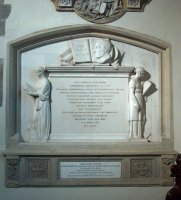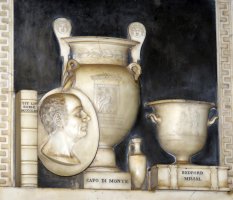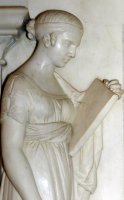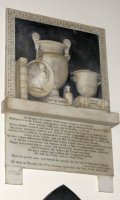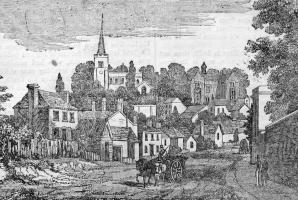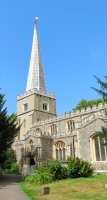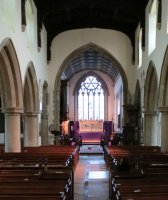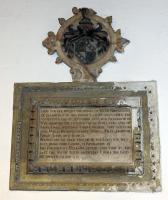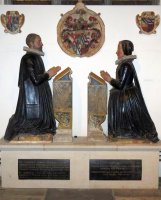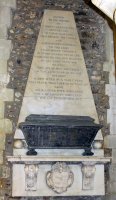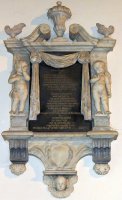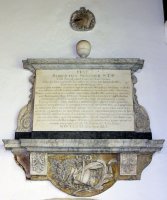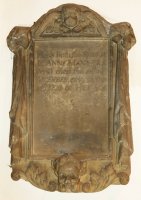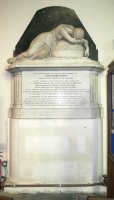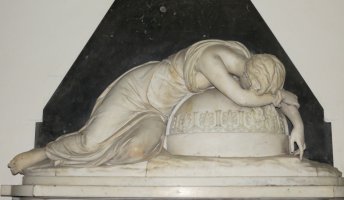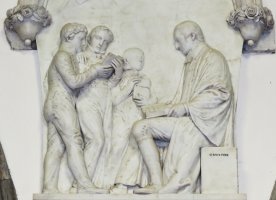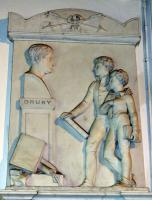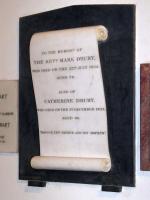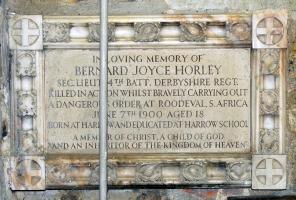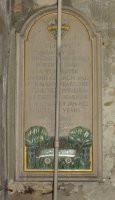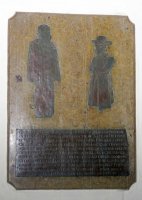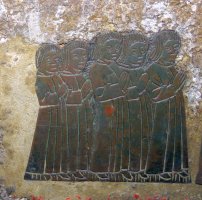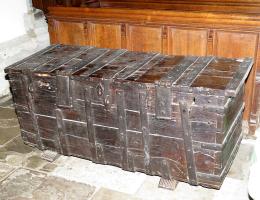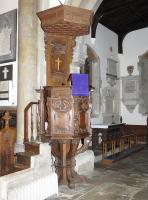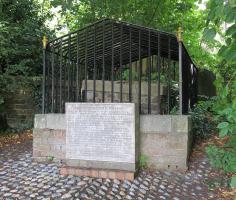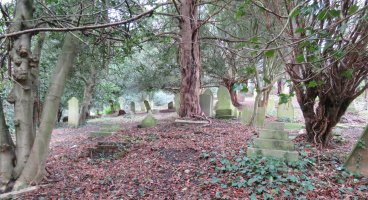St Mary's Church, Harrow - Monuments in 10 Minutes
A 10 minute look at the monuments in St Mary's Church, Harrow on the Hill, West London. We have a pair of kneeling Jacobean statues, a beautiful mourning girl statue, and 18th and 19th Century wall panels including several figure pieces with important sculptors represented, and several brasses. This was the young Byron's church, and the visitor can enjoy his same splendid hilltop view.
This page is for those who have only a short time to glance round the Church and its monuments at the top of Harrow Hill. If you have more time or come back for a longer visit, then see this much fuller description, and this page for the Churchyard.
The Church itself is a building of the 12th Century through to the 15th Century: much of the tower is 12th Century, with Norman windows, the Nave 13th Century, with additions in the 15th Century including the ceiling, and a 19th Century workover by the architect George Gilbert Scott. There was a Saxon church before, for a Saxon grave of a young woman has been found there, its position marked on the floor inside.
Harrow on the Hill: Parish Church of St Mary.
Inside, there is a medieval ambience, with dark wood furnishings and that high 15th Century ceiling supported on carved brackets and tall Gothic arches, and the numerous monuments on the walls. Among them are works by the sculptor Peter Scheemakers, the famous John Flaxman, Richard Westmacott the Younger of a sculptural dynasty, and several significant makers of funereal monuments: Peter Turnerelli, Humphrey Hopper and Gaffin of Regent Street.
The Gerrard monuments.
The oldest stone monuments in the Church are to the Gerard family, in the north transept. There is a panel and coat of arms to William Gerrard, d.1584, "late of Flamberds in this parish", and his wife Dorothe, d.1583, and a reassembled monument with kneeling, painted statues of William Gerard, d.1609 and his wife - statues like this typify the 16th and 17th Centuries, with husband and wife praying at desks called faldstools, kneeling n cushions, and wearing shapeless robes with wide ruffs. Once there would have been a colourful backing and a canopy above.
Scheemakers' obelisk to Thomas Graham, and Edward Waldo, Baroque.
Among the 18th Century wall panels, first see the very large obelisk and casket on the North wall, to Thomas Graham, d.1733, 'Apothecary to their Majesties King George the I and II, and Apothecary General to the Army', and his wife Anne Graham, d.1724 - picture above left. There are carved flowers on the brackets below, with a central cartouche, and this is a typical piece by the important sculptor Peter Scheemakers.
18th Century: Sumner and Manners monuments.
Other 18th Century pieces to pick out are the Classical Baroque panel to Edward Waldo, d.1707, with knotted drapery and mourning cherubs, the panel to Anne Manners, d.1739, with a winged cherub head and a carved skull crowned with a wreath, and Robert Sumner, d.1771, with a streaky yellow marble base bearing a carved parchment with quill pens, and branches with delicate foliage. Picture above right - you will need to click to enlarge and see the detail.
Humphrey Hopper's statue of J.H.North's mourning wife.
From the 19th Century, we have several good figure pieces. You see the best one on the opposite wall as you enter the Church - a girl in light Classical drapery, collapsed in grief on the tomb of her husband, John Henry North, d.1831, Judge of the Admiralty in Ireland. A truly admirable work, in the modelling of her limbs, the proportions of her figure, the simple yet subtle drapery, and overall composition, by the monumental sculptor Humphrey Hopper.
Harrow boys: John Lyon and Joseph Drury.
John Lyon founded Harrow School - there is a brass to him, see lower down, and an 1815 monument by the famous sculptor and designer of Wedgwood Porcelain John Flaxman. He carved a high relief scene of the Founder, gowned and with book in hand, faced by a group of three Harrow boys, wearing tall-collared shirts tucked into loose trousers (picture above left). And we have a second Harrow schoolboy scene, this time with two boys facing a Roman-style bust to Joseph Drury, d.1835 (picture above right - click to enlarge). The sculptor was Richard Westmacott the Younger (see this page), son of the illustrious sculptor, Sir Richard Westmacott RA, of the British Museum pediment.
Also carved by Westmacott the Younger is the panel to George Butler, d.1853, with Greek girls emblematic of Literature and Architecture (for allegorical figures, see this page), and a portrait of Butler in relief with books, scrolls and mortar board.
19th Century sculpture: Butler and Edwards.
In the Chancel is one more sculptural piece, to James Edwards, d.1816, 'one of the most eminent Collectors and Booksellers in Europe' - his portrait is among Classical pots and books. By the portrait sculptor Peter Turnerelli, born in Belfast and of Italian descent.
Thomas Gaffin's panel to Revd. Mark Drury, carved as a scroll.
Among simpler monuments in the Church are typical white-on-black panels, including one carved as an unrolling scroll, to Revd. Mark Drury, d.1835, and his wife Catherine Drury, d.1825, by Thomas Gaffin, of a very prolific firm of monument makers based in Regent Street - see this page.
Arts and Crafts Horley monuments.
And from the 20th Century, look on the Nave north wall for Lieutenant Bernard Joyce Horley, d.1900, characteristic Arts and Crafts pinkish alabaster, with thick border with leafy carved blocks (picture above left); and a relative, John Theodore Horley, d.1922, a blind arched window with a coloured relief of oak trees and field flowers (above right).
Ancient brasses: John Lyon and wife, Aynesworth children.
There are several brasses around the Church. One must-see on is that to John Lyon, d.1592, whose later monument by Flaxman we saw above, and his unnamed wife. The inscription starts 'Heare lyeth buried the bodye of John Lyon, late of Preston, in this parish, yeoman, decd. the 11th day of Octr. in the year of our Lord 1592, who hath founded a Free Grammar School in the Parish, to have continuance for ever...' His brass is complete, hers is partial, but with the most excellent hat. Another brass to seek out, in the south Transept and usually part-hidden behind a row of chairs, is to George Aynesworth, d.1488/9, and his successive wives Agnes, Isabel and Joan. They stand in a row, hands held in prayer. Underneath, the numerous offspring, very much smaller and charmingly grouped (above right - click to enlarge).
12th Century font, 17th Century chest and pulpit.
Aside from the monuments, the Church retains its original Norman font, as old as the oldest part of the Church fabric itself, squat, massive and circular. From the 17th Century we have the pulpit with carved scrolling and half-figures, and a great chest bound with straps of iron. And from the 19th Century, a good collection of stained glass windows, with numerous small angels high up.
Where Byron used to sit.
Outside the Church, the young poet Byron, studying at Harrow School, used to come and sit on the flat-topped tomb of Peachey, from whence a view of many miles can be seen flanked by trees. Below the Church enclosure, the churchyard sprawls down the hillside, evocatively gloomy under dark trees, tombstones in various states of ruination, including a notable specimen of Victorian mosaicwork near the path, the family tomb of the 19th century painter and illustrator John Leighton. Lots of pictures on this page.
And the fuller page describing all the monuments in the Church is here.
The evocative churchyard (click to enlarge).
Nearby in Middlesex: West to Ruislip Church // North-West to Pinner Church // South to Perivale Church or Greenford Church // South-East to Willesden Church //
North to Harrow and Wealdstone sculpture // Sculpture on the Uxbridge Line
